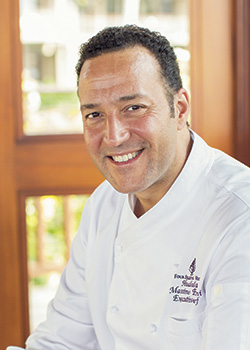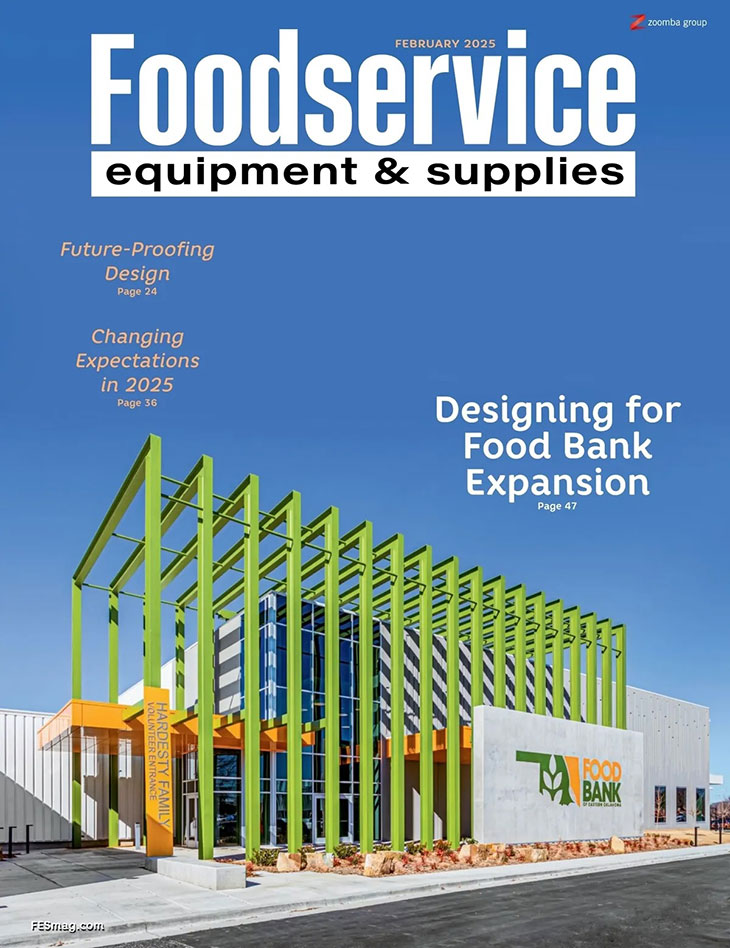Rome native Chef Massimo Falsini has made Hawaii his career high point, home and paradise.
 Chef Massimo Falsini
Chef Massimo Falsini
As executive chef of one of the world’s top-rated and Hawaii’s No. 1-rated hotel according to Condé Nast Traveler, Falsini oversees a team of 150 employees and at both the Four Seasons Resort Hual?lai’s 243-room luxury hotel and multimillion dollar residential property consisting of 220 private homes.
Set on the North Kona Coast of Hawaii’s Big Island, Four Seasons Resort Hual?lai offers 24-hour in-room dining; the Hual?lai Grille, a 280-seat, dinner-only steakhouse; ‘ULU Ocean Grill, a 184-seat restaurant focused on local and regional food and seafood with a modern Hawaiian flare; a sushi lounge and a beachside café serving lunch and dinner. The property also has a catering operation with banquet capacity for groups up to 700 people. On the residential side, Falsini oversees two private club restaurants as well as a beachside bar and surf club café. At its maximum, the hotel serves up to 2,200 people a day, with the busiest month being December.
FE&S: Assuming the hotel draws luxury-seeking travelers, how would you describe the clientele on the residential side?
MF: The Four Seasons started developing the residential side in the ’90s and it has become some of the most exclusive real estate in the United States. Some people live here year-round, while others use it as a vacation home. Many of the businessmen and women who own property here also have multiple homes around the world. They want the amenities like a gym, spa, golf club and water activities. There are even sommeliers that can help develop wine cellars. This is the new way to do luxury hotel business.
FE&S: That must create quite a demand for the best-quality food possible — both at the hotel and on the residential side. How do you cater to both groups?
MF: Residential property owners can enjoy their own private restaurants and come to all the outlets at the hotel, but there are two restaurants that are private and only for the residents. The residents have a little different perspective than the hotel guests who may come for a week or two. The residential owners purchase a home for life so we must maintain a strong partnership with them. We focus on only the best, local and regional foods, the freshest produce, grass-fed beef and seafood. Our guests and residents expect that level of quality. They shop organic, buy the best food, and eat at the best restaurants around the world. At a five-star, five-diamond resort such as ours, they expect to have the best fish in the world prepared perfectly.
FE&S: With such high-volume demands, how do you make the food taste great?
MF: It is actually very simple: we have an impressive local sourcing program, one of the best within our company and in North America. Almost 35 percent of our ingredients are sourced locally. The Big Island of Hawaii is like a chef’s theme park because the season is always moderate — at the lowest the temperature is 25 degrees Celsius (77 degrees F) up to 31 degrees Celsius (88 degrees F) so we have a constant growing season and year-round access to fresh produce. We also have a very large heritage of cattle here, with many grass-fed breeds, and top-quality seafood caught every morning that we can serve day-of.
We also have about a 1,000-square-meter garden at the hotel and produce a lot of different produce, including tropical fruits like bananas and papaya, Meyer lemons and kaffir limes, pommelos, lemongrass, eggplant and every herb you can think of. We actually have another small garden located next to the bars where bartenders can pick herbs for the drinks.
FE&S: How do you educate your guests about the foods you serve and grow?
MF: We have many farm-to-table dinners and other special events and often mention farmers on our menus. Food like this should be available for everyone — when we mass produce food we lose the quality and nutrients and the food becomes useless. Our farm-to-table and local sourcing program should be the norm — in Europe it is. I arrived in the U.S. five years ago from Italy where chefs never buy food from a catalogue.
FE&S: You must have access to amazing seafood being in Hawaii — how do you source your fish?
MF: We are lucky to have a 100 percent local sourcing program for seafood. We bring all different types of shellfish and Big Island lobster and abalone from two sustainable farms here. We also have a sustainable Kampachi farm here. When Kampachi grows wild it develops a lot of mercury from the ocean water so they have developed a cleaner system to raise the white fish we often use for sashimi and sushi. Of course, Ahi tuna is abundant — most of the tuna in Japan comes from here.
FE&S: How do you stay on top of food and other trends to stay current with your customers?
MF: I read a lot and network with other chefs and industry colleagues, and I travel a lot. I try to visit New York, San Francisco and Chicago on the mainland every year and eat in a lot of restaurants so I can see what our guests like to eat.
We are also able to exchange talent through our Four Seasons properties and do a lot of food and wine festivals. Chefs from all over the U.S. come to cook here, and we travel to Four Seasons in other cities to cook there.
FE&S: I’m sure you’re seeing a growing demand for healthier cuisine?
MF: Our guests are extremely health conscious and many are on special diets and spend a lot of time in the gym. We pride ourselves on having extremely personalized service. I even have guests who send me a grocery list of what they can eat. I cannot put out a dish that’s not the freshest salad or the tastiest tomato and everything has to be fresh and organic or local. We also try to control the sugar and salt quantities in our food. Processed food doesn’t enter our kitchen at all. Certain brands don’t even come to this resort because of that. We can’t put a 3,000 calorie dish on the menu anymore. The food has to be clean, unfussy. Nobody likes sugary glazes, and you don’t see as much crispy char-grilled proteins anymore.
FE&S: What about guests with allergies — how do you cater to them?
MF: We run a daily allergy list for the front-of-the-house staff and they are trained to systematically ask if there are any allergies at every table. When allergy orders come into the kitchen they are printed on different color paper and flagged with the name of the guest and the room number, so when a guest is seated we know what their allergy is. We use new pots and pans, new china and dedicated ovens, and all the preparation and dishwashing is separated. Even if it isn’t a life threatening situation, we still treat food preferences as an allergy. This pays back because our guests are more comfortable eating at our restaurants — they know if they go to a Four Seasons they will be taken care of.
FE&S: With such a high volume and so many special diets, how do you set up your kitchen to be as efficient as possible?
MF: Each restaurant has its own kitchen, and then we have a banquet kitchen. This is important, too, because it gives our chefs the ability to design a menu that works with the equipment he has in his kitchen. We also have to be extremely efficient and organized because sourcing equipment is a challenge being in Hawaii. If you’re in San Francisco and your fridge breaks you can get another one the next morning. Here you call and maybe next month you get a new fridge. So first of all you have to plan. You cannot easily fly things in because it would cost three or four times more. Everything comes in on a barge. We have to have a very strong equipment maintenance program and a strong cleaning program and work very closely with our engineering department to reduce breakage. We also have to calculate the life of equipment a little earlier. A certain brand might last five years for most people but here we have to plan on having to buy that equipment again in four years.
FE&S: What about some of the more technologically advanced equipment on the market — do you use those pieces?
MF: There is also not as much room for complexity; the cooking has to be very focused on simplicity of execution and the quality of the ingredient. For instance, it doesn’t make sense for a place like here to use a combi steamer with a touchscreen and a Bluetooth because if it breaks, no one can fix it. We try to go back to basics with our equipment selection and cooking style. For example in Hawaii, we cook the pig in the dirt — you can buy a $10,000 special oven but you still won’t cook the pig as well as that. We don’t use powders or foams. We cure the natural way with salt.




